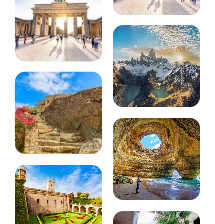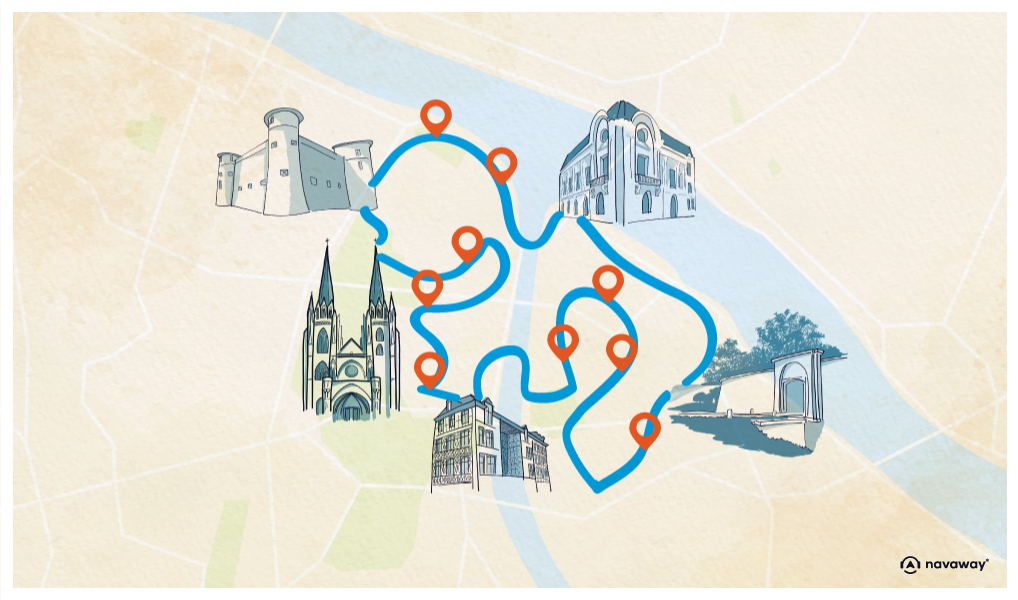
The 12 most beautiful villages in the French Basque Country
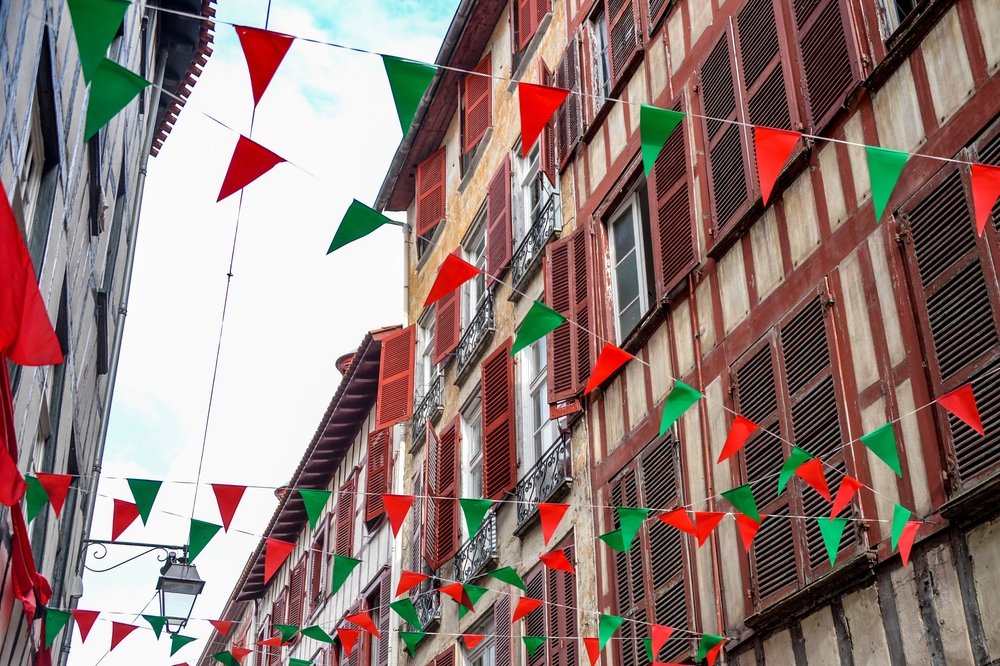
The French Basque Country is a region enchanted by its authenticity, preserved traditions and distinctive architecture. Set between the Atlantic Ocean and the Pyrenees mountains, its typical villages with their red and white half-timbered houses tell the story of a thousand years of history. Whether you’re a lover of heritage, gastronomy or simply looking for a change of scenery, these 12 most beautiful villages in the French Basque Country promise unforgettable discoveries. From the cobbled streets of Sare to the colourful facades of Ainhoa and the chilli peppers of Espelette, each village has its own unique identity and inimitable charm.

Also in the Basque Country guide :
- Visit Bayonne in 1 day: 22 things to do and see on foot
- Biarritz in 1 day: 16 things to do and see on foot
- The most beautiful villages to visit around Bayonne
- What to do in the Basque Country
- 9 walks around Biarritz on the Basque coast
- The 7 most beautiful beaches in the Basque Country
- Nouvelle-Aquitaine: Must-sees and must-dos
- Top 10 culinary specialities in Biarritz
- The 6 best surf spots in Biarritz
1. Sare, the rebel village at the foot of the Rhune
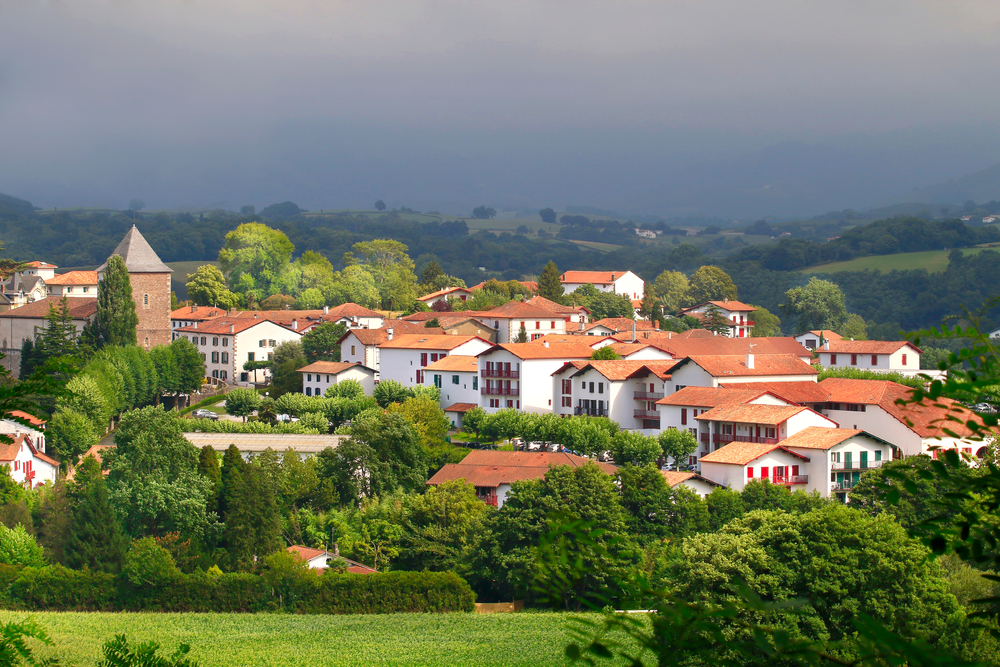
Listed as one of the most beautiful villages in France, Sare nestles at the foot of the Rhune and Axuria mountain ranges, on the Spanish border. This authentic Labourd village has retained its Basque soul, with traditional red half-timbered houses lining picturesque lanes. The history of Sare is closely linked to smuggling, a practice that has made many local families prosper for centuries.
Sare’s architectural heritage deserves special attention. L’Ortillopitz (Chemin Ortillopitz, 64310 Sare), a perfectly restored 17th-century house museum, plunges you into the daily life of a Labourdine family. The 17th-centurychurch of Saint-Martin (Place du Fronton, 64310 Sare, rated 4.6/5 on Google out of 187 reviews) impresses with its three-storey wooden galleries and gilded Baroque altarpiece.
Nature lovers will be delighted by the prehistoric caves of Sare (Route des Grottes, 64310 Sare, rated 4.3/5 on Google for 2,789 reviews), where a scenographic trail reveals human occupation dating back 10,000 years. For a breathtaking view of the region, take the little Rhune cogwheel train up to the summit at an altitude of 905 metres. From up there, the panorama takes in the Atlantic Ocean, the Pyrenees and the rolling Basque countryside.
2. Ainhoa, a bastide gem on the road to Santiago de Compostela
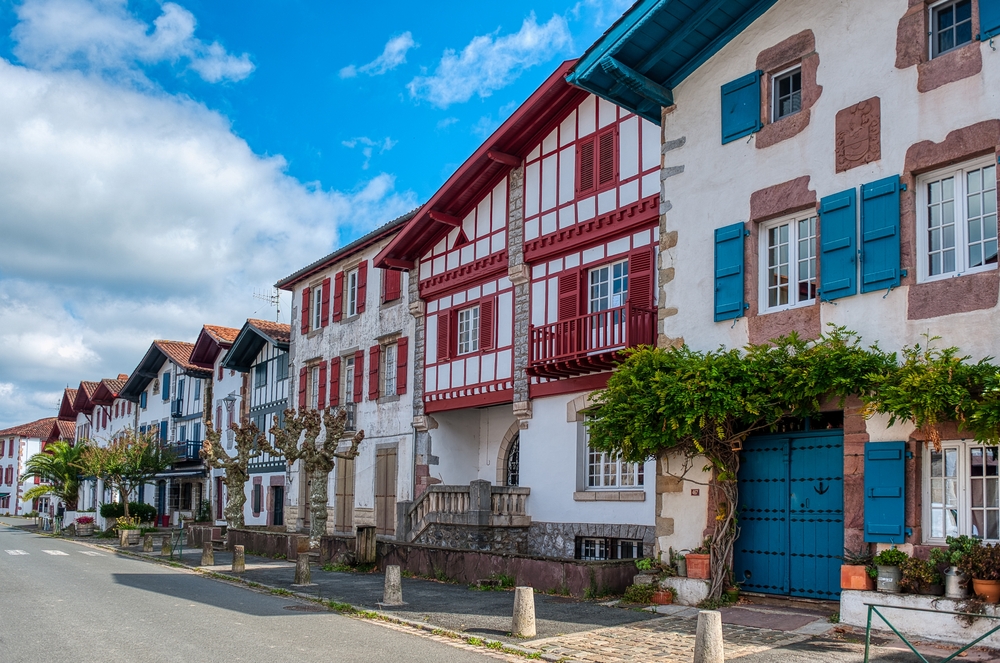
Founded in the 13th century on the route to Santiago de Compostela, Ainhoa is a bastide town in Navarre that has preserved its original medieval layout. Listed as one of the most beautiful villages in France, this village on the border between Labourd and Navarre stands out for its remarkably homogenous architecture. Along its single street, traditional 17th-century Basque houses line up their white facades with oxblood red or dark green half-timbering.
Each house has a name engraved on its lintel, bearing witness to the ancient families who lived there. Thechurch of Notre-Dame-de-l’Assomption (Place du Fronton, 64250 Ainhoa), built in the 13th century, has a typically Basque bell tower and superimposed wooden interior galleries. The sculpted capitals on the portal are also worth a look.
The village has resisted modern urbanisation, refusing any construction that would disrupt its architectural harmony. Stroll along the cobbled streets, admire the balconies decorated with red geraniums and stop off at one of the small craft shops to sample the local sheep’s cheese, ardi gasna, or homemade jams. For hikers, the Lizuniaga pass trail offers a beautiful walk with views of the Pyrenees and the surrounding valley.
3. La Bastide-Clairence, the royal bastide with its narrow flower-filled streets
Founded in 1312 by King Louis X of Navarre, La Bastide-Clairence is the only Navarrese bastide town in the French Basque Country. Listed as one of the most beautiful villages in France, this medieval town stands out for its geometric grid layout, typical of the bastides of the south-west. The houses, dating from the 16th to 18th centuries, harmoniously blend Basque, Navarrese and Gascon influences, with their half-timbered walls painted burgundy red or bottle green.
The central arcaded square, the beating heart of the village, used to be home to the market and fairs. Thechurch of Notre-Dame-de-l’Assomption (Place de l’Église, 64240 La Bastide-Clairence, rated 4.6/5 on Google out of 31 reviews) has a surprisingly unusual interior with three storeys of carved wooden galleries, testimony to the social hierarchy of yesteryear. Don’t miss the Jewish cemetery (Chemin d’Harrieta, 64240 La Bastide-Clairence), one of the oldest in France, bearing witness to the Sephardic Jewish community that settled here in the 17th century.
La Bastide-Clairence specialises in arts and crafts. The village is home to around thirty artists’ and craftsmen’s workshops: potters, woodcarvers, ironmongers, weavers, etc. Take a stroll along the cobbled streets with their evocative names, such as rue du Four or rue Notre-Dame, and push open the doors of the shops to discover these traditional skills perpetuated with passion.
4. Saint-Jean-Pied-de-Port, gateway to the Pyrenees and pilgrimage

A major stopover on the route to Santiago de Compostela, Saint-Jean-Pied-de-Port is a fortified town in Basse-Navarre that has managed to preserve its medieval character. Listed as one of the most beautiful villages in France, this historic town nestles in a meander of the Nive de Béhérobie river, at the foot of the Roncesvalles pass. Its name evokes its strategic position “at the foot of the port” (passage) to Spain.
The village is divided into two distinct parts. The upper town, dominated by the Vauban citadel (Route de la Citadelle, 64220 Saint-Jean-Pied-de-Port, rated 4.6/5 on Google for 1,523 reviews), offers an exceptional panoramic view of the ramparts, the slate roofs and the Pyrenees. The old town, accessible via the Porte Saint-Jacques, features steep streets lined with medieval pink sandstone houses. Rue de la Citadelle, the main thoroughfare, is lined with traditional shops and half-timbered houses where pilgrims have been buying supplies for centuries.
The Pont Romain (also known as the Pont Notre-Dame), spanning the Nive, offers a picture-postcard view of the houses with wooden balconies overlooking the river. The church of Notre-Dame-du-Bout-du-Pont (Place Floquet, 64220 Saint-Jean-Pied-de-Port), built in the 14th century of red sandstone, has a sober Gothic style. For a totally immersive experience, take the walkway that winds along the ramparts and admire the rolling landscape of the Basque Pyrenees.
5. Espelette, the land of red chillies

World-famous for its AOC chilli pepper, Espelette is undoubtedly the most famous village in the French Basque Country. Situated in the province of Labourd, this picturesque village offers a striking sight in autumn when the facades of the houses are adorned with garlands of drying scarlet chillies. This emblematic spice, introduced in the 16th century by Basque sailors returning from the Americas, is now the pride and joy of the village.
The village centre features narrow streets lined with traditional Basque houses with white walls and red shutters. The Château des Barons d’Ezpeleta (Place de l’Église, 64250 Espelette), an 11th-century building remodelled in the 17th century, dominates the main square with its elegant stone and brick architecture. Saint-Étienne church (Place de l’Église, 64250 Espelette), dating from the 17th century, impresses with its Trinitarian bell tower-porch and gilded Baroque altarpiece.
Don’t miss a visit to the Atelier du Piment (Route du Labourd, 64250 Espelette, rated 4.4/5 on Google out of 442 reviews), where you can discover the secrets of growing and processing this unique condiment. Every year at the end of October, the village organises the famous Fête du Piment, a festive event that attracts thousands of visitors to celebrate Ezpeletako Biperra. Take the opportunity to sample the local specialities: Bayonne ham with chilli, spicy ewe’s milk cheese, spicy chocolate, etc.
6. Saint-Pée-sur-Nivelle, between lake and mountain
Nestling in the Nivelle valley, Saint-Pée-sur-Nivelle is a Labourd commune with a population of around 6,200. This typically Basque village boasts an exceptional natural setting, halfway between the Atlantic Ocean and the foothills of the Pyrenees. Its geographical position makes it an ideal destination for families looking for tranquillity and outdoor activities.
The 12-hectare Lac de Saint-Pée-sur-Nivelle (Route du Lac, 64310 Saint-Pée-sur-Nivelle, rated 4.5/5 on Google out of 3,892 reviews) is the village’s green lung. Fed by four natural springs, this year-round lake has a fine sandy beach with lifeguard surveillance in summer, perfect for family bathing. An easy 3-kilometre walk takes you all the way around the lake, offering shaded areas ideal for picnics and observing the local wildlife.
The village itself is well worth a visit. The church of Saint-Pierre (Place de l’Église, 64310 Saint-Pée-sur-Nivelle), built in the 16th century, has a beautiful bell tower and interior wooden galleries. Theecomuseum of Basque Pelota and Xistera Pilotari (Pilotari Museoa, 7 Place de la Mairie, 64310 Saint-Pée-sur-Nivelle, rated 4.7/5 on Google out of 46 reviews) plunges you into the world of this traditional sport emblematic of the Basque country. A host of water sports and leisure activities are on offer, including pedalos, paddle boats, canoes, tennis and tree climbing.
7. Itxassou, the icing on the cake
Situated on the fertile plain between the Urzumu, Mondarrain and Artzamendi mountains, Itxassou is a Labourd village on the River Nive. This authentic commune is famous throughout the Basque Country for its cherry production, a fruit that is the subject of an annual festival in June. Itxassou’s cherry orchards, planted on the hillsides, offer an enchanting sight in spring with their immaculate white blossoms.
The village unfolds its typical neighbourhoods of low whitewashed houses with red or green shutters and steep slate roofs. Th echurch of Saint-Fructueux (Place de l’Église, 64250 Itxassou, rated 4.6/5 on Google for 34 reviews), built in the 17th century, boasts a magnificent Baroque altarpiece and superimposed wooden galleries typical of Basque churches. The Pont Romain (Chemin du Pont Romain, 64250 Itxassou), spanning the River Nive, actually dates back to the Middle Ages and was used by transhumance herds.
Hiking enthusiasts will be delighted by the many trails that criss-cross the surrounding area. The ascent of Pas de Roland, the mythological site where the valiant knight is said to have split the mountain with a blow from his sword Durandal, offers spectacular views over the valley. The village celebrates its star fruit at the Cherry Festival in June and its cultural heritage with the Errobiko Festibala festival in July, featuring Basque music and traditions.
8. Ustaritz, the historic capital of Basque pelota
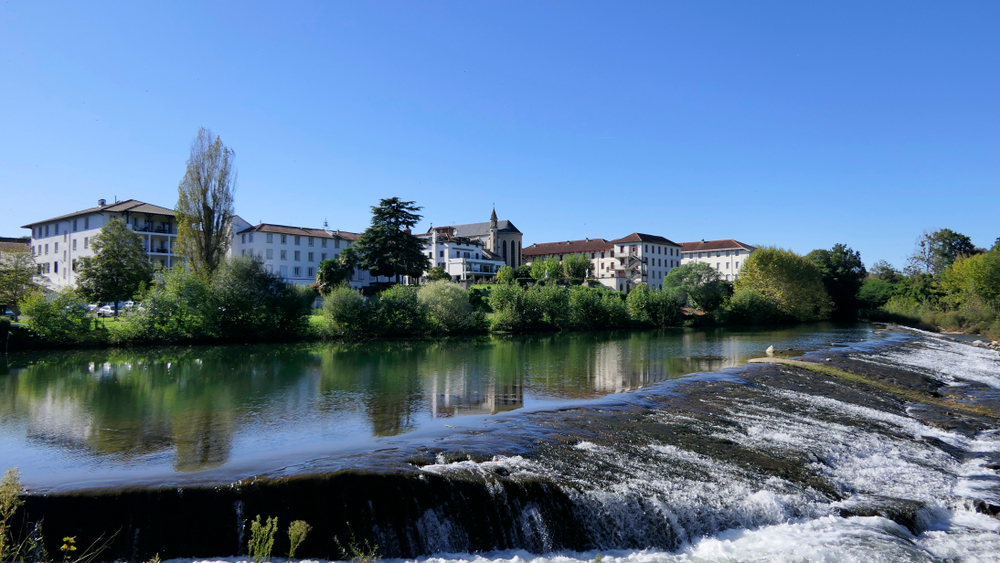
Ustaritz, the capital of the Labourd district, proudly claims to be the capital of Basque pelota. This ancestral sport, a veritable institution in the Basque Country, is said to have originated in this village, where the first professional pelota school, Kapito-Harri (1 Rue Harguindéguy, 64480 Ustaritz), was founded in 1920. This renowned academy has trained many champions and continues to pass on this spectacular ball game.
The village is divided into several districts with traditional Basque houses. The church of Saint-Vincent (Place de l’Église, 64480 Ustaritz), built in the 17th century, dominates the central square with its imposing bell tower. The interior features a beautiful gilded altarpiece and carved wooden galleries. Château de Lota (1 Allée du Château, 64480 Ustaritz), an 18th-century residence listed as a Historic Monument, is now home to the Basque Cultural Institute. This reference centre works to preserve and promote the Basque language and culture.
The village is set in lush green countryside, perfect for country walks. The banks of the River Nive offer pretty shady paths where you can enjoy a leisurely stroll. Ustaritz is also renowned for its local producers of ewe’s milk cheese, peppers, honey and Basque cakes. The weekly Thursday morning market gives you the chance to discover these local products and meet the passionate craftspeople who keep the traditional skills alive.
9. Urrugne, on the Basque coast facing the ocean
At the gateway to Spain, Urrugne is a vast Labourd municipality covering more than 5,000 hectares, from the coast to the foothills of the Pyrenees. The village offers exceptional views of the Atlantic Ocean from the famous Corniche Basque, a winding road that winds between cliffs and secret coves. This privileged position between sea and mountains makes it a popular holiday destination.
Urrugne’s architectural heritage bears witness to a rich history dating back to the Middle Ages. Château d’Urtubie (64 Route d’Ascain, 64122 Urrugne, rated 4.6/5 on Google out of 872 reviews), a 14th-century medieval fortress transformed into an elegant Renaissance residence, was home to Louis XI, Louis XIV and Napoleon III. Surrounded by wooded parkland, it can be visited from April to October and reveals its furnished flats, formal gardens and restored stables.
The church of Saint-Vincent (Place de l’Église, 64122 Urrugne, rated 4.6/5 on Google for 62 reviews), built in the 16th century, boasts a remarkable Trinitarian bell tower and rich Baroque furnishings. Don’t miss the Socorri chapel (Chemin de Socorri, 64122 Urrugne, rated 4.7/5 on Google out of 107 reviews), perched high above the village and offering panoramic views over the bay of Saint-Jean-de-Luz. Hiking enthusiasts will love the paths that lead to the summit of Mount Xoldokogaina, from where the view stretches along the Basque coast as far as Biarritz.
10. Arcangues, distinctive blue elegance
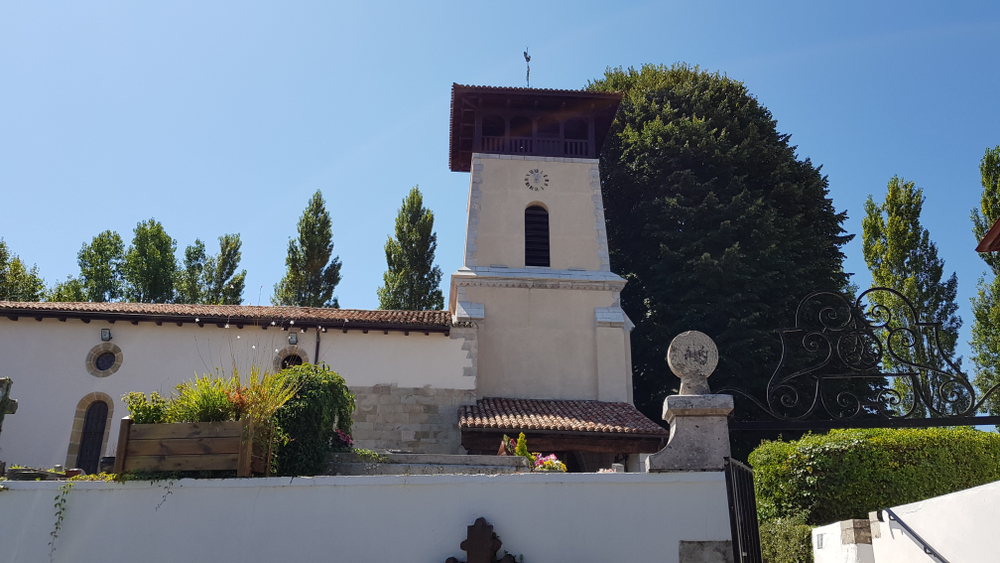
At the gateway to Anglet and Biarritz, Arcangues is a residential Labourd village that has managed to preserve its authenticity despite its proximity to coastal towns. This hilly village is characterised by the famous “bleu d’Arcangues”, a unique colour that adorns the shutters and half-timbering of many of the houses, created in the 19th century by the Arcangues family who ruled the village for many years.
The central square is the heart of the village, with its town hall and school with its blue-arcangue shutters, the pelota court where lively games are played, and the Auberge d’Achtal (1 Place du Fronton, 64200 Arcangues, rated 4.2/5 on Google for 287 reviews) with its large schist tables serving traditional Basque cuisine.
The church of Saint-Jean-Baptiste (Rue de l’Église, 64200 Arcangues, rated 4.7/5 on Google out of 89 reviews), built in the 17th century on the ruins of an earlier sanctuary, impresses with its single nave and curious bell tower with three triangular gables one above the other. The adjoining cemetery is home to the tomb of the famous singer Luis Mariano, a child of the Basque country whose flower-filled grave is regularly visited by his admirers. The village offers beautiful country walks in a hilly setting dotted with traditional farmhouses andxeak.
11. Bidart, an unspoilt seaside resort between cliffs and beaches
Situated between Biarritz and Saint-Jean-de-Luz, Bidart is a charming seaside resort in the Labourd region that has retained its character as an authentic Basque village despite the growth in tourism. Perched on a rocky promontory overlooking the Atlantic Ocean, this commune offers an exceptional natural heritage with its six beaches nestling at the foot of verdant cliffs and its spectacular views over the Basque coast.
The village’s historic centre, set back from the coast, unfurls its quiet lanes around the Place Sauveur Atchoaren, where the traditional market is held. Notre-Dame-de-l’Assomption church (Place de l’Église, 64210 Bidart, rated 4.5/5 on Google out of 67 reviews), built in the 16th century and altered in the 17th, boasts a magnificent gilded Baroque altarpiece and carved wooden galleries. Its typically Basque bell tower dominates the landscape.
The old Bassilour mill (Chemin de Bassilour, 64210 Bidart) dates back to the 16th century and bears witness to the village’s agricultural past. Fully restored, it is open to visitors and explains the process of turning wheat into flour. Bidart offers a wide range of activities: surfing on the beaches of the Côte des Basques and Ilbarritz, golf on the renowned Ilbarritz course, horse-riding in the surrounding area and, of course, Basque pelota at the municipal pelota court (Place du Fronton, 64210 Bidart). Let us guide you in your discovery of Bidart so that you don’t miss out on any of its hidden treasures.
12. Ciboure, Luis Mariano’s fishing port
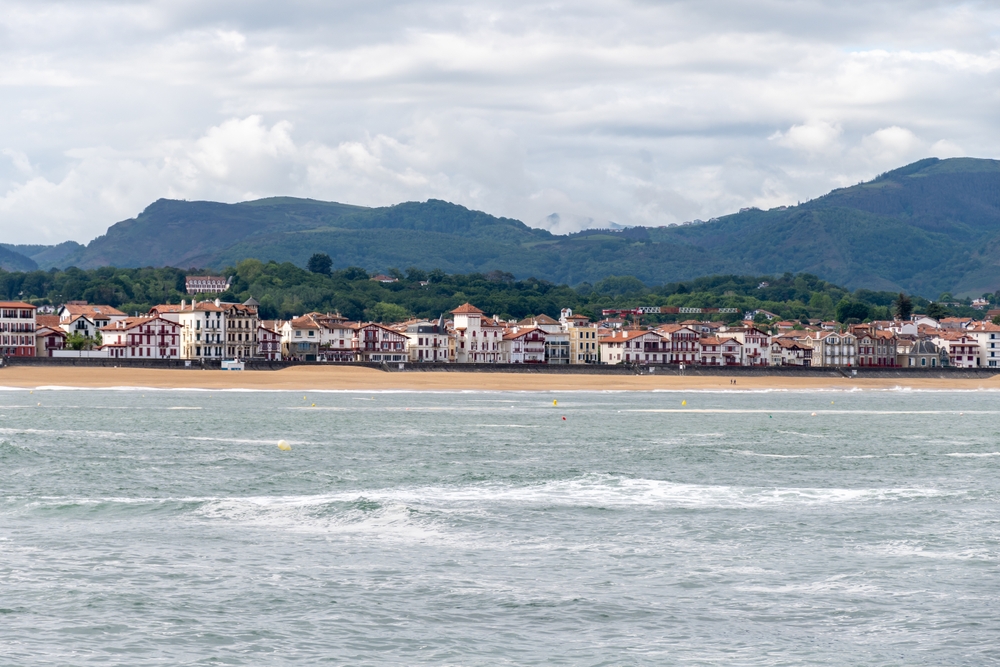
Opposite Saint-Jean-de-Luz on the other side of the mouth of the River Nivelle, Ciboure is a picturesque fishing village in the Labourd region. This port community has preserved its authenticity, with old stone and half-timbered houses lining the quays, a maritime atmosphere and culinary traditions. The fishing port, which is still in operation, brings in anchovies, sardines and tuna every day, making the reputation of the local gastronomy.
The district of Socoa, a former fishing village attached to Ciboure, is well worth a visit with its 17th-century fort (Digue de Socoa, 64500 Ciboure, rated 4.5/5 on Google out of 1,245 reviews) built by Vauban to protect the bay of Saint-Jean-de-Luz. A 250-metre dike links the fort to the beach, offering a seafront promenade with views of the ocean and the Pyrenees. The church of Saint-Vincent (Place Camille Jullian, 64500 Ciboure, rated 4.5/5 on Google for 124 reviews), built in the 16th century, has a remarkable octagonal bell tower in the flamboyant Gothic style.
Ciboure is the birthplace of composer Maurice Ravel and tenor Luis Mariano. The house where Ravel was born (Quai Maurice Ravel, 64500 Ciboure, rated 4.3/5 on Google for 215 reviews) can be visited and immerses music lovers in the world of the creator of “Boléro”. Don’t leave Ciboure without trying ttoro, a tasty Basque-style fish soup made from local fish and served with a slice of toasted bread rubbed with garlic. The terraces of the harbour restaurants provide the ideal setting for savouring this speciality while admiring the ballet of the fishing boats.
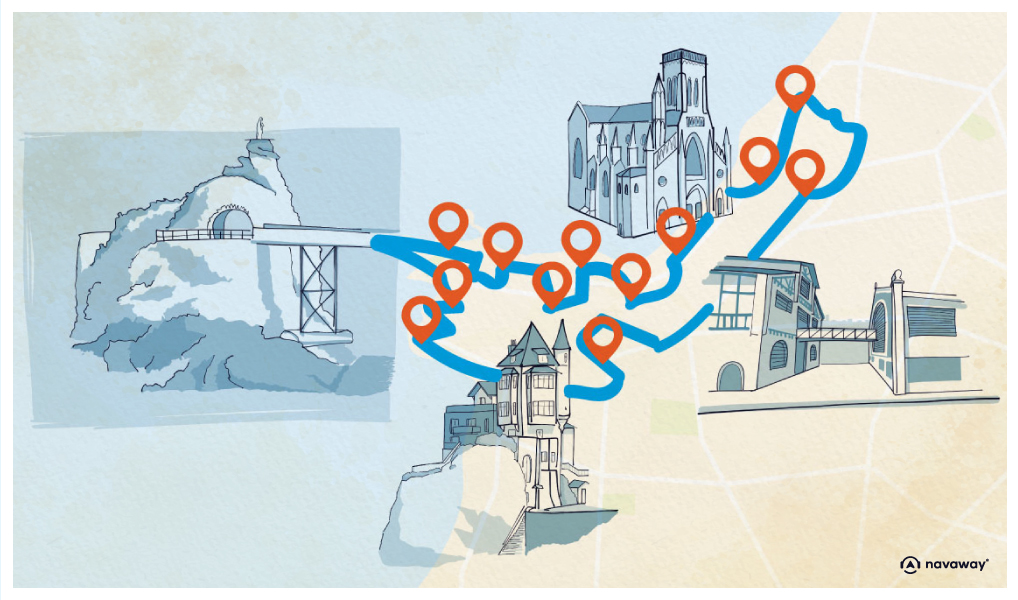
As you explore these 12 most beautiful villages in the French Basque Country, you’ll have travelled through a land of contrasts, where mountain and ocean, tradition and modernity, history and the art of living blend harmoniously. Each village tells its own story of the Basque identity forged over the centuries by French and Spanish influences. The red and white half-timbered houses, the churches with their superimposed wooden galleries, the lively pelota courts, the colourful markets and the passionate producers form a vivid picture of a unique and well-preserved culture. Whether you’re looking for architectural heritage, nature walks, authentic gastronomy or simply a refreshing change of scenery, the French Basque Country will win you over with its diversity and authenticity. Don’t hesitate to take the time to wander through the narrow streets steeped in history, chat to the locals who are always ready to share their love of the country, and let yourself be immersed in the very special atmosphere that makes this region so irresistibly charming. For a more in-depth exploration, the audioguided tour of Biarritz, allows you to explore on your own the treasures of this emblematic city, which is an excellent starting point for exploring these authentic villages.
Frequently asked questions about the villages of the Basque Country
Which is the most beautiful village in the French Basque Country?
While it is difficult to single out just one of the most beautiful villages, each with its own unique charm, Sare, Ainhoa, La Bastide-Clairence and Saint-Jean-Pied-de-Port are officially listed among the “Most Beautiful Villages in France”, a distinction that rewards their exceptional heritage and preserved authenticity. Espelette also remains a must-see for its worldwide renown.
How long does it take to visit these villages in the Basque Country?
To discover these 12 villages properly, ideally plan between 4 and 7 days. This will allow you to spend half a day in each village, soaking up the local atmosphere, sampling the local cuisine and doing a few hikes. An extended weekend allows you to visit 4 or 5 villages, concentrating on those that appeal to you most.
When is the best time to visit the villages of the Basque Country?
Spring (April-June) and autumn (September-October) are the ideal seasons to discover these villages in optimum conditions. Temperatures are pleasant, tourist numbers are moderate and you can enjoy the traditional festivals. Summer is the busiest time of the year, but also the busiest. Autumn is spectacular in Espelette when the peppers are drying.
Can you visit these villages without a car?
Although the car is the most practical way to travel between these often remote villages, some are accessible by public transport from Bayonne or Saint-Jean-de-Luz (notably Espelette, Sare and Ainhoa). Regular bus services link the main towns. For the best possible experience, car hire is still recommended, especially for the more isolated villages such as Ustaritz or La Bastide-Clairence.
Where to stay to visit these villages in the Basque Country?
Bayonne is an excellent central base, with a wide range of accommodation on offer (hotels, B&Bs, rentals). Saint-Jean-de-Luz also offers a good compromise between proximity to the ocean and access to the villages. For total immersion, opt for a bed and breakfast or self-catering cottage directly in one of the villages, where you can live at the local pace and meet the locals.
200 audioguided tours for cities all around the world
Download